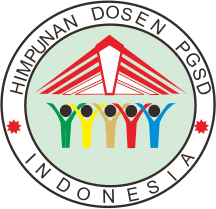Profil miskonsepsi pemahaman peserta didik terhadap materi pecahan ditinjau berdasarkan gaya belajar visualization auditory kinesthetic (vak) pada peserta didik kelas v sekolah dasar
Abstract
Abstract. The purpose of this study is to analyze and describe the profile of misconceptions based on the Visualization, Auditory, Kinesthetic (VAK) learning style regarding students' understanding of fractions and the causes of misconceptions in the fifth grade of SD Negeri Wonosri. This research is a qualitative research method. The research subjects were the fifth grade students of SD Negeri Wonosri. Data collection techniques are learning style tests, fractional material tests, interviews with teachers, and interviews with students. The validity of the data using technical triangulation techniques. Data analysis used descriptive analysis techniques. The research procedure is the initial preparation, the research implementation stage, the data processing stage, and the data presentation.The results showed that two research subjects who had a visualization learning style experienced systematic misconceptions and numeracy misconceptions. Two research subjects who have an auditory learning style experience systematic and translation misconceptions. Two other research subjects have a kinesthetic learning style experiencing systematic misconceptions. Factors causing students to experience misconceptions are preconceptions, lack of understanding of concepts, low interest in learning, teacher teaching methods that are too fast, lack of understanding of steps, students' associative thinking.
Key Words: misconception, fraction material, learning style, and elementary schoolKeywords
Full Text:
PDFReferences
[1] Depdiknas, “UNDANG-UNDANG REPUBLIK INDONESIA NOMOR 20 TAHUN 2003 TENTANG SISTEM PENDIDIKAN NASIONAL DENGAN,” p. 255, 2003.
[2] D. A. Putri, R. Winarni, and A. Surya, “Analisis kesulitan belajar pemecahan masalah matematika berdasarkan newman procedure pada peserta didik kelas V sekolah dasar,” Didakt. Dwija Indria, vol. 9, 2021.
[3] S. S. Dewanti, S. P. Si, M. P. Si, J. Marsda, and A. No, “ANALISIS MISKONSEPSI MAHASISWA PROGRAM STUDI KALKULUS I DITINJAU DARI GAYA BELAJAR,” pp. 1–17, 2014.
[4] N. A. Saleh, Riyadi, and S. Kamsiyati, “Profil kesalahan peserta didik sekolah dasar dalam menyelesaikan soal cerita matematika materi penaksiran,” Didakt. Dwija Indria, no. 449, pp. 1–6, 2021, [Online]. Available: https://jurnal.uns.ac.id/JDDI/article/view/49141.
[5] Waryani, “Dinamika Kinerja Guru dan Gaya Belajar (Konsep dan Implementasi Terhadap Prestasi Belajar),” Penerbit Adab (CV. Adanu Abimata), 2021.
[6] B. & M. H. DePorter, Quantum Learning: Membiasakan Belajar Nyaman dan Menyenangkan (Alih Bahasa: Alwiyah Abdurrahman. Bandung: Kaifa, 2015.
[7] A. A. P. Kinasih, “Penggunaan media dalam pembelajaran Tema 7 Indahnya Keragaman di Negeriku ditinjau dari gaya belajar siswa di kelas IV F SD Ta’mirul Islam Laweyan Surakarta tahun ajaran 2019/2020,” Didakt. Dwija Indria, p. 6, 2021, [Online]. Available: https://digilib.uns.ac.id/dokumen/detail/83075/Penggunaan-Media-dalam-Pembelajaran-Tema-7-Indahnya-Keragaman-di-Negeriku-Ditinjau-dari-Gaya-Belajar-Siswa-di-Kelas-IV-F-SD-Tamirul-Islam-Laweyan-Surakarta-Tahun-Ajaran-20192020%0Ahttps://digilib.uns.ac.id/do.
[8] N. Nurhamdiah and A. N. Rangkuti, “Profil Miskonsepsi Siswa Pada Materi Pecahan Berdasarkan Tingkat Kemampuan Matematika Siswa,” EKSAKTA J. Penelit. dan Pembelajaran MIPA, vol. 4 (1), p. 49, 2019, doi: 10.31604/eksakta.v4i1.49-59.
[9] P. Sugiyono, Metodologi Penelitian Kuantitatif Kualitatif dan R&D. Bandung: Alphabeta, 2019.
[10] D. P. N. Hutami, “Analisis Miskonsepsi Siswa dalam Menyelesaikan Soal Barisan dan Deret Berdasarkan Certainty of Response Index (Cri) Ditinjau dari Gaya Kognitif Reflektif dan Impulsif,” Digit. Repos. Univ. Jember, 2018, [Online]. Available: https://repository.unej.ac.id/handle/123456789/86491.
[11] E. L. Saleem, H., Bagayoko, D., and Kelley, “Misconceptions and The Certainty of Response Index (CRI),” J. Phys. Educ, vol. 34 (5), pp. 294–299, 1999.
[12] P. Suparno, Miskonsepsi & Perubahan Konsep dalam Pendidikan Fisika. Jakarta: Gramedia Widiasarana Indonesia, 2013.
[13] M. Ibrahim, Konsep, Miskonsepsi, dan Cara Pembelajarannya. Surabaya: Unesa University Press, 2012.
[14] G. Sa’idah, “Penerapan startegi Pembelajaran PDEODE (Predict-Discuss-ExplainObserve-Discuss-explain) Untuk Merduksi Miskonsepsi Siswa pada Materi Hidrolisis Garam di SMA Negeri 2 Bojonegoro,” Universitas Negeri Surabaya, 2011.
[15] H. . Rakhmah, “Miskonsepsi Siswa pada Materi Permutsi dan Kombinasi di Kelas XII SMA Taruna Bumi Khatuliswa,” vol. 9 (7), pp. 27–28, 2020.
Refbacks
- There are currently no refbacks.



